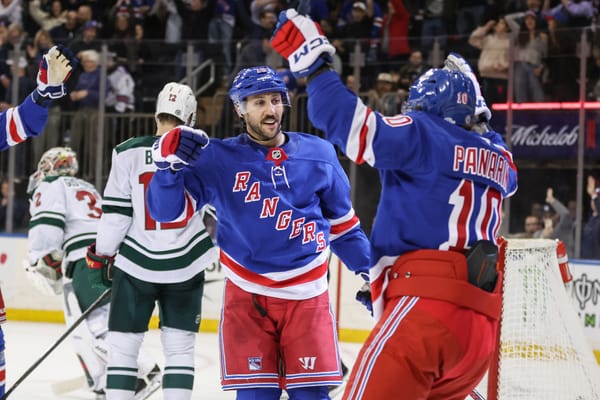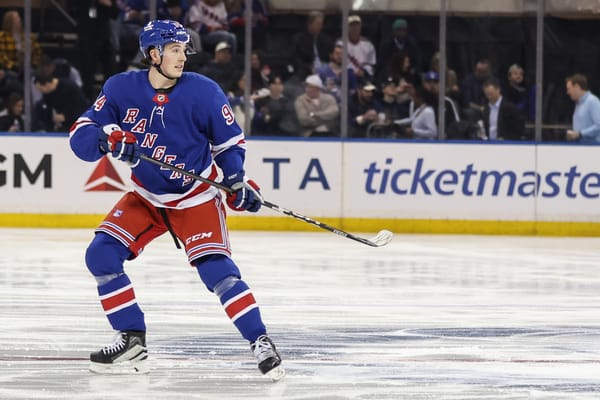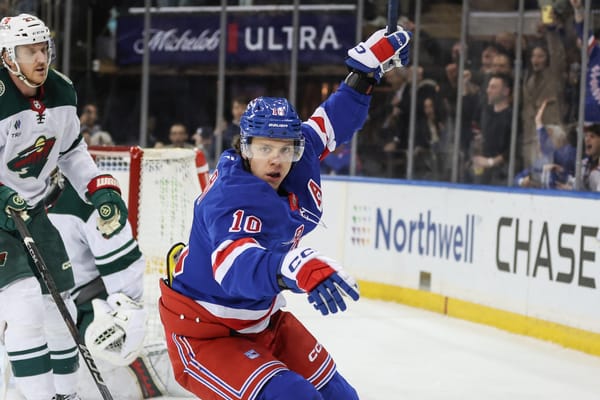What Have We Learned? A Look at the First Three Games
The New York Rangers have played the first three of their 82 games so far, earning two points, scoring 9 goals, and allowing 12 goals against. First, the Rangers fell 4-2 to the Colorado Avalanche in their season opener. Next, they dropped their first away game of the season in Toronto by a score of 8-5. In their third game, against the Montreal Canadiens back at Madison Square Garden, the Rangers finally collected their first win with a 2-0 victory.
The results from the Rangers first three games have been mixed, but there are a number of takeaways throughout the lineup and behind the bench worth noting. There are some aspects of these games that have been encouraging, like the play of Pavel Buchnevich, and others that are concerning, like the coaching decisions.
There’s a lot to unravel here, so rather than going through a recap of each game – all of which you can find here on Blueshirt Banter – let’s explore what we’ve learned from these games.
The first line, featuring Chris Kreider, Mika Zibanejad, and Pavel Buchenvich, known as the “KZB” line, has been fantastic so far. At 5v5, this combination has played 29.64 minutes and accumulated a 51.92 Corsi for percentage and a 56.84 expected goals for percentage. They’ve managed this despite some mixed zone starts, facing the same percentage (26.32) of 5v5 starts in the offensive and defensive zone.
Zibanejad’s already scored four goals – three of which were on the power play. There’s been so much talk about the Rangers’ center depth and the expectations for Zibanejad as a first-line center for the first time in his career this offseason, so while it’s obviously unrealistic for him to continue scoring at this rate, his start to the season nonetheless looks promising.
His linemate, Buchnevich, may have been the Rangers’ best forward in their first three games. Seeing Buchnevich receive the ice time he deserves after such a shortened rookie season is really exciting, particularly since there’s so much potential to unlock – potential that should have been seen last year. Against Colorado, it was Buchnevich on the ice in the most crucial moments as the Rangers were trying to tie the score in the final minutes, a definite change of pace from last season. So far, he’s earned two assists, both of which put his skilled playmaking and vision on display.
Last season, Buchnevich’s usage was concerning, especially in the second half of the season and the playoffs. Maybe if Buchnevich had a more consistent role in the lineup and more of an opportunity, the Rangers could have tapped into that skill sooner. If Buchnevich has a breakout season this year, there’s a good chance head coach Alain Vigneault will be credited for his development, when in reality it’s more likely that Buchnevich is just that talented and given the ice time, he’ll show it.
Developing offensive talents like Buchenvich isn’t exactly Vigneault’s strength, and in this young season, that’s on display again with his management of Filip Chytil. Chytil, the Rangers 2017 21st overall draft pick, made such a strong impression in the preseason that he earned a place in the opening night lineup between Mats Zuccarello and Rick Nash on the second line. But among all 20 skaters that have appeared in the Rangers’ lineup this season, Chytil has the lowest 5v5 ice time of 12.65 minutes.
In the season opener against Colorado, it’s possible Chytil didn’t see more than 7:40 because of the frequency of special teams situations. For whatever reason, Chytil wasn’t used on the power play, a questionable decision in itself; because he wasn’t, it is tough to draw conclusions from his ice time in the first game. However, he saw even less ice against Toronto (4:59) and wasn’t used at all in the second half of the game.
The Rangers only have 9 games to decide how to proceed with Chytil and whether or not it’s worth it to burn the first year of his entry-level contract. In those 9 games, it’s incredibly important that Chytil actually sees the ice so management can decide whether or not he is ready to play at the NHL level or is better off developing elsewhere. There wasn’t much in either of his first two games to warrant a scratch in the third game, but it’s better not to waste another one of his few NHL games by leaving him on the bench.
The question remains whether general manager Jeff Gorton and Vigneault are on the same page with this, as it doesn’t seem likely that Gorton chose to keep Chytil at the NHL level for this little of an opportunity. If it continues this way, it doesn’t look like he’ll be in New York much longer – and at this point, it’s for the best.
In these first three games, there have been some defensive lapses. That said, the Rangers hadn’t played a preseason game since Tuesday, September 26, and these players didn’t necessarily have enough time during preseason to develop chemistry. Gorton significantly revamped this blue line (for the better!), and there’s bound to be some growing pains.
Kevin Shattenkirk has elevated the Rangers’ power play already. The first unit, with Shattenkirk, Kreider, Zibanejad, Buchnevich, and Zuccarello, has the potential to be lethal. Regardless of assistant coach Scott Arniel’s handling of the power play, it should improve because of the talent on it, especially with Shattenkirk quarterbacking. That’s something the Rangers have lacked in recent years, and it’s becoming clear that they found what they’ve been looking for.
Shattenkirk goal pic.twitter.com/Q7IWVerJX2
— steph (@myregularface) October 8, 2017
When the Rangers fell behind to the Maple Leafs in the first period, Vigneault reacted by changing his defensive pairs. Marc Staal was moved to the first pair and Ryan McDonagh was moved to his off side. It’s not to say this wasn’t the right move at the time – Staal did score a goal and an assist to help the Rangers come within reach in the second period – but it’s discouraging to see Vigneault revert back to his ways in the second game of the season.
Far too often, Vigneault turned to his veterans, including Staal, last season despite their damaging play. It’s not a habit that he should get into, especially when there are much stronger defenders to be promoted to the first pair. And switching their best defenseman to his off side isn’t ideal either – the goal should be to facilitate his game in any way possible, not to risk diminishing it.
Brendan Smith struggled to start to the season, and he has less of an excuse than offseason additions Shattenkirk and Tony DeAngelo because he was on this team at the end of last season and played alongside his current partner, Brady Skjei, all throughout the playoffs. His lackluster play thus far, depicted by his low Corsi for percentage (40) and expected goals for percentage (40.19), may have earned him a place in the press box for the Rangers’ third game of the season – unless his absence was due to an undisclosed injury.
It’s not that Smith’s play wouldn’t normally warrant a healthy scratch, it’s just that it’s a little early for this reaction. Vigneault has a history of holding young players accountable for their play in this way, but not holding his veterans to the same standard. If this is him setting a precedent for the season, then by all means, but consistency is key moving forward. On the other hand, if the intention was to play seven defensemen against Montreal, maybe this wasn’t the best game to scratch Smith because it put Steven Kampfer in the lineup.
Oddly enough, Kampfer was in the lineup Sunday, and not even as the seventh defenseman. That position was saved for DeAngelo, who only played 3:45 minutes total (1:37 minutes of which were on the power play). DeAngelo was guilty of a damaging turnover against Toronto in the first period, one that resulted in a goal against, but he was still deployed later that game, totaling 12:12 minutes of ice time. Maybe his minimal usage against Montreal was some sort of discipline for that mistake, but that would be odd because it took away a place in the lineup for someone to actually contribute. If anything, that decision put the team at a disadvantage, and they were already at enough of a disadvantage with the combination of Nick Holden and Kampfer on the ice.
Kampfer ended up playing 17:08 in total on Sunday, while Holden played 17:14 – both of which exceeded Skjei’s 16:33 time on ice. The usage of Kampfer and Holden was questionable to say the least, as they hurt the Rangers’ chances, consistently finding themselves hemmed in the defensive zone and struggling to exit. Holden ended the night with a -17 5v5 Corsi differential and Kampfer with a -14, which translated to a 16 and 23.08 Corsi for percentage respectively.
Holden and Kampfer’s play only contributed to the Rangers’ shortcomings in this game – they trailed in shot attempts (63-43 in all situations, 34-25 at 5-on-5) and expected goals against (1.97-1.46 at 5v5) to the Canadiens. The only reason the Rangers were able to get past Montreal was Henrik Lundqvist.
Lundqvist didn’t have an ideal start to the season, as he looked pretty rusty against the Avalanche on Thursday. It’s worth remembering that he didn’t play a game since Monday, September 28, in preseason, so that rust should have been expected. The defense was pretty loose in front of him Thursday, which didn’t help either.
Even though Lundqvist wasn’t his sharpest on Thursday, the Rangers were the better team as they led the Avalanche in shot attempts (69-44), shots (39-26), and expected goals (4.43-3.64). It’s just that Semyon Varlamov’s game-changing play led the Avalanche to victory.
Lundqvist didn’t have the best start against the Maple Leafs on Saturday either, but more than anything, the Rangers were absolutely dominated in the first period (the Maple Leafs earned a 4.25 expected goals for in the first frame alone), and they couldn’t support their netminder. Against the Canadiens, however, Lundqvist showed why he’s The King as earned his first win and shutout of the season. The Rangers’ can’t rely on Lundqvist to carry them like he has in the past, as they’ve proven it takes more than just a generational talent in net to hoist a Stanley Cup, but it doesn’t mean he can’t be the difference-maker like he was Sunday.
It’s only been three games, so a lot is bound to change for the Rangers. Already some bad habits are reappearing, but there have been some positive takeaways too. There’s a long season ahead and there’s a lot of room for this team to grow.
A “rebuild on the fly” was undertaken by Gorton to keep this team competitive in front of Lundqvist, giving them another chance at the Stanley Cup while simultaneously building for the future. In order to succeed moving forward, not only do the players have to improve, but the coaches have to as well – if not, it’s going to be a long season… at least, for the players.
*Data via Corsica.hockey




